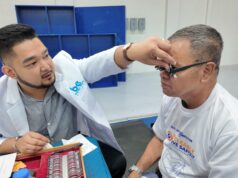CLARK FREEPORT, Pampanga- It’s a chance to see the moon’s craters, Jupiter with its rings, and even UFO’s through astronomical telescopes.
Philippine astronomers in various parts of the country will bring out their powerful telescopes to the streets and allow the public to use them to observe night skies as part of the country’s commitment to participate in the worldwide “100 hours of astronomy” (100 HA) from April 2 to 5.
In an interview with Punto, Dr. Cynthia Celebre, chief of the Space Science and Astronomy Section of the Philippine Atmospheric, Geophysical and Astronomical Services Administration (PAGASA), said at least 13 astronomical societies nationwide will participate in the project launched by the United Nations Educational, Scientific and Cultural Organization (UNESCO) and the International Astronomical Union (IAU).
She said 147 countries will be participating in the 100 HA. The participation of the Philippines, she noted, would be based on Proclamation No. 1630 signed by Pres. Arroyo on Sept. 29 last year, committing the Philippines to the observation of 2009 as the International Year of Astronomy and to the holding of the 100 HA from April 2 to 5.
Dr. Armando Lee, national organizer of “sidewalk astronomers” for the 100 HA, said the project will commemorate the 400 years of Galileo’s use of the telescopes in astronomy. He said the event will be the first to be ever to mark Galileo as “the first real astronomer” and his use of the telescope in astronomy.
“We will train our telescopes on Jupiter and the moon whose craters could be visible as we expect clear skies especially in the Philippines during the span of the 100 HA,” he said. Venus, however, is expected to be too far in the horizon by then.
Celebre said one of the key goals of 100 HA is to have as many people as possible look through a telescope as Galileo did for the first time 400 years ago.
Thus, she said that 10-inch Galileo telescopes from Japan are now available in the market and information on where they could be bought, at about US$10 each, could be provided by her office.
Celebre said that while the objective of the 100 HA is to commemorate Galileo, it is also meant to arouse interest of the public, especially the youth, in astronomy.
It could also be a chance for those interested in UFO’s or unidentified flying objects to scour the skies for one, she added.
“We really should be open minded and be scientific in our approach to UFO’s,” she said, noting that her office has a unit which specializes in UFO studies.
Celebre said that in Manila, two powerful telescopes from PAGASA will made accessible to the public at the Mall of Asia and at Sulaiman Park in Malate.
Telescopes for the public will also be available at the Rizal Technological Institute in Madaluyong City, the only school in the country offering a course combining engineering and astronomy, she noted.
The Astronomers’ League of the Philippines (ALP) and other astronomical societies will also sponsor “sidewalk astronomy” in Cebu, Puerto Princesa, Cagayan de Oro, Davao and Legaspi cites.
Lee said that while Venus is expected to be too far on the horizon during the span of the 100 HA, telescopes could reveal Saturn with its rings cutting across the middle, or the craters of the moon.
Philippine astronomers in various parts of the country will bring out their powerful telescopes to the streets and allow the public to use them to observe night skies as part of the country’s commitment to participate in the worldwide “100 hours of astronomy” (100 HA) from April 2 to 5.
In an interview with Punto, Dr. Cynthia Celebre, chief of the Space Science and Astronomy Section of the Philippine Atmospheric, Geophysical and Astronomical Services Administration (PAGASA), said at least 13 astronomical societies nationwide will participate in the project launched by the United Nations Educational, Scientific and Cultural Organization (UNESCO) and the International Astronomical Union (IAU).
She said 147 countries will be participating in the 100 HA. The participation of the Philippines, she noted, would be based on Proclamation No. 1630 signed by Pres. Arroyo on Sept. 29 last year, committing the Philippines to the observation of 2009 as the International Year of Astronomy and to the holding of the 100 HA from April 2 to 5.
Dr. Armando Lee, national organizer of “sidewalk astronomers” for the 100 HA, said the project will commemorate the 400 years of Galileo’s use of the telescopes in astronomy. He said the event will be the first to be ever to mark Galileo as “the first real astronomer” and his use of the telescope in astronomy.
“We will train our telescopes on Jupiter and the moon whose craters could be visible as we expect clear skies especially in the Philippines during the span of the 100 HA,” he said. Venus, however, is expected to be too far in the horizon by then.
Celebre said one of the key goals of 100 HA is to have as many people as possible look through a telescope as Galileo did for the first time 400 years ago.
Thus, she said that 10-inch Galileo telescopes from Japan are now available in the market and information on where they could be bought, at about US$10 each, could be provided by her office.
Celebre said that while the objective of the 100 HA is to commemorate Galileo, it is also meant to arouse interest of the public, especially the youth, in astronomy.
It could also be a chance for those interested in UFO’s or unidentified flying objects to scour the skies for one, she added.
“We really should be open minded and be scientific in our approach to UFO’s,” she said, noting that her office has a unit which specializes in UFO studies.
Celebre said that in Manila, two powerful telescopes from PAGASA will made accessible to the public at the Mall of Asia and at Sulaiman Park in Malate.
Telescopes for the public will also be available at the Rizal Technological Institute in Madaluyong City, the only school in the country offering a course combining engineering and astronomy, she noted.
The Astronomers’ League of the Philippines (ALP) and other astronomical societies will also sponsor “sidewalk astronomy” in Cebu, Puerto Princesa, Cagayan de Oro, Davao and Legaspi cites.
Lee said that while Venus is expected to be too far on the horizon during the span of the 100 HA, telescopes could reveal Saturn with its rings cutting across the middle, or the craters of the moon.




